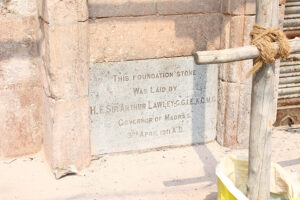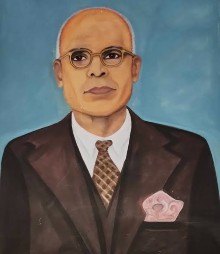Registered with the Registrar of Newspapers for India under R.N.I 53640/91
Vol. XXXI No. 14, November 1-15, 2021
Archives: Vol. XXXI No. 14, November 1-15, 2021
Corporation elections, at long last
by The Editor
Finally, there are signs that the elections to the city’s corporation will be held. If reports in the newspapers are to be believed, the Greater Chennai Corporation has begun work to ensure that the elections to the office of Mayor and also that of 200 councillors will happen by January 2022 or so. Though a formal announcement to this effect has not been made, the preparations are already under way – the polling stations are being checked for suitability, especially in the light of the pandemic. In addition, the revised electoral list is being worked upon. Nodal officers to fulfil various tasks leading up to the polls have already been assigned. If the polls go as per plan, we should have an elected council in place by February 2022 at the latest.
Our city’s Corporation, holding the record for being the oldest in India, has another and not so distinguished claim to fame. It is probably the only civic body in India to be administered by special officers and not an elected council for long periods of time. Following what was known as the muster roll scandal that brought to light the fact that the civic body was paying salaries to several non-existent employees, the money being divided among the elected councillors and some employees, the council was suspended in 1973. The city was thereafter administered by a special officer of the IAS cadre. Matters remained this way till 1996, when elections were once again held. For the first time that year, the office of Mayor was also thrown open to public franchise, this being earlier subject to nomination among the elected councillors. Thereafter, we had functioning councils till 2015 when elections were not held with one flimsy excuse after the other being given. Now, after a gap of six years, once again under a special officer, the Corporation will have elections.
The DMK was in power in the State and in the council when the muster roll scandal broke. The Government had no option but to dissolve the council, faced as it was with several embarrassing revelations about its party men. Thereafter the Emergency intervened and when the MGR-led ADMK came to power in the State, it showed no inclination to hold civic body elections. This was because the city was widely perceived to be a DMK bastion, and the ADMK-led State Government could not stomach the possibility of a DMK-led council in the capital city’s civic body. Post MGR, the DMK was in power for a brief while – too brief to consider holding civic polls. The succeeding Jayalalithaa-led ADMK Government did not bother with such matters, once again possibly because the DMK could win in the council.
CMWSSB plans to make a splash with current and new projects in its portfolio
by our Special Correspondent
The Chennai Metropolitan Water Supply and Sewerage Board (CMWSSB) has a clutch of interesting projects on hand at the moment. In a chat with Madras Musings, Mr. P. Akash, Executive Director, CMWSSB, speaks about the organisation’s goals, ongoing projects and pioneering schemes.
Recently, the World Bank announced the $150 million Chennai City Partnership: Sustainable Services Program, which included among its goals the improvement in the quality of water supply and sewerage in the city. The Singara Chennai 2.0 initiative that was unveiled earlier this year has also placed a focus on water management, allotting Rs. 200 crores to the Metro Water from its budget. The department has quite a few vital projects in the pipeline.
“We’re at a critical juncture. Compared to the past, a lot of activities are underway,” said Mr. Akash when asked about the current workload at CMWSSB. He offered a brief background of the organization’s work to illustrate the pace at which the team is meeting milestones today.
Heritage Watch
When the past goes up in smoke

William Satish, an avid reader of Madras Musings, and more importantly a heritage buff who goes around photographing much of what is left from our past in the city, sent us this photograph. In his accompanying note he asked us if we knew of this building. Rather sadly, we had to admit that we did. Praised once by Viceroys and the venue for several memorable meetings, including one by Mahatma Gandhi, Lawley Hall, better known as the India Silk House building on Mount Road/Anna Salai, is now a burnt-out shell.
A papier‑maché human anatomical model in the Madras Medical Establishment in the 1830s
by Ramya Raman and Anantanarayanan Raman
An untitled 2-page note by John Carnac Morris,1 signed ‘ED.’ at the end, sleeved under ‘Scientific Intelligence’ in the inaugural issue of the Madras Journal of Literature & Science [MJLS] (Morris, 1834) refers to a human-anatomical model in Madras (Fig. 1). Made by a French physician, Louis Auzoux, this model was noticed in the MJLS because of its ‘interactive’ endowment and near-human size. The model was unique, because it could be dismantled to view internal body parts and re-fitted snugly to its normal human appearance. Thus it was amenable for learners of medicine in an interactive manner.
The Madras Medical School (M.M.S.) formally commenced in February 1835, shortly after Morris’s above-referred notice. The General Hospital in Madras (M.G.H.) was operating for army personnel from 1772, which started serving the general public in the 1840s.
Delhi’s ‘Madrasi’ school set to complete 100 years
by M.R. Narayan Swamy

P.H. Sundaresa Iyer, the founder-teacher of DTEA.
There could not have been a more modest birth. Who would have imagined that a school with just one student and one teacher in a small room would eventually blossom into one of the best schools in the Indian capital, producing exemplary academic results year after year!

